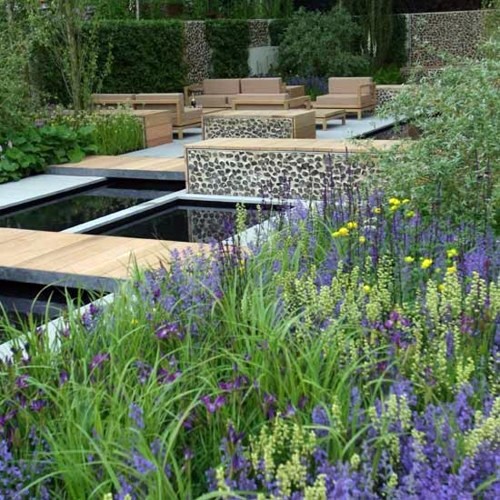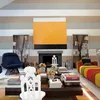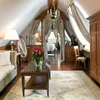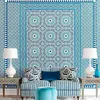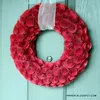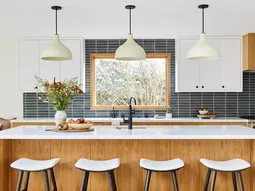Make great combinations the most of your garden!
Do you want because the formal and casual mix in the design elements of your home? I'd love to do it again and again. The source of inspiration for me above all by the fabulous scenery of formal gardens, which are determined by the flow, informal paintings. Many gardens from the middle of the last century were executed in a very traditional style. This was the main trend particularly in some communities gardens and parks. You have used in different seasons, different plants to fill borders. English garden designer William Robinson was used at the time to design a more natural garden. In the opinion of the formal approach is appropriate in some cases, namely when accessing their natural carpet arrangements of geometric shapes in the garden. Both views were later replaced by another. While Edwards era, also known as the Belle Epoque, the two super-designer Gertrude Jekyll and architect Edwin Lutyens have formal and informal mixed design. Lutyens is a young architect who designed the Cenotaph in London. This also applies to the House of Viceroy in New Delhi, India. He has extensive experience in designing it skeletons. He was the best, not only to put the right plant in the right place, but also to complete this by the complex architectural structure of the apartments ad
Beautiful design and landscaping garden
 See Using an additional drawings and the combination with permissive formal elements were then the norm and modern conceptions of the gardens is based. This rigorous, above ground planters uplifting can dominate in the garden. The intelligent use of the design of informal facilities that makes it softer and provides a balance. Gertrude Jekyll added many simple rules. These are some simple, such as checking the compatibility of plants for gardens specially designed for them. In the next picture you can see another example of the harmony between the strict and random elements
See Using an additional drawings and the combination with permissive formal elements were then the norm and modern conceptions of the gardens is based. This rigorous, above ground planters uplifting can dominate in the garden. The intelligent use of the design of informal facilities that makes it softer and provides a balance. Gertrude Jekyll added many simple rules. These are some simple, such as checking the compatibility of plants for gardens specially designed for them. In the next picture you can see another example of the harmony between the strict and random elements  The gardens designers Jekyll and Lutyens always shown a geometrical arrangement, combined with an asymmetrical appearance. The large Brugmansia plant is at the heart of the design, but not overwhelmed by this. Even in modern gardens can release more good design is formal. No informed the other repealed. Cut boxwood balls imprecise create a rhythm of plants, which reflect the strict lines of the walls and sidewalks. Stains plants, informal Break Free on it somehow. According Lutyens it is in nature without any line or curve. Each line or curve is subjected to forces by which it was made. Precisely such a conviction to follow the diagrams in this figure. Get crafty in which case this design? Free planting not only makes the soft landscape, but transforms the entire area into a work of art. According Jekyll and Lutyens garden should look like a fine production of the house without much extravagance. The entrances and areas adjacent to buildings tend to be always very formal
The gardens designers Jekyll and Lutyens always shown a geometrical arrangement, combined with an asymmetrical appearance. The large Brugmansia plant is at the heart of the design, but not overwhelmed by this. Even in modern gardens can release more good design is formal. No informed the other repealed. Cut boxwood balls imprecise create a rhythm of plants, which reflect the strict lines of the walls and sidewalks. Stains plants, informal Break Free on it somehow. According Lutyens it is in nature without any line or curve. Each line or curve is subjected to forces by which it was made. Precisely such a conviction to follow the diagrams in this figure. Get crafty in which case this design? Free planting not only makes the soft landscape, but transforms the entire area into a work of art. According Jekyll and Lutyens garden should look like a fine production of the house without much extravagance. The entrances and areas adjacent to buildings tend to be always very formal  The gardens can be supplied with wood trimmed hedges tree or other evergreens. These facilities could also serve as a wonderful link between the sidewalk and the house. Using less formal plant compound is much softer and both parties achieve a harmonious interaction
The gardens can be supplied with wood trimmed hedges tree or other evergreens. These facilities could also serve as a wonderful link between the sidewalk and the house. Using less formal plant compound is much softer and both parties achieve a harmonious interaction  In the figure, we see a mixture of Miscanthus sinensis (Chinese section) with a series of low plants. Some people consider this type definition not garden design. But it is definitely a smart garden design. The horizontal juniper growth could be as wonderful on its own. Then he offers an informal break from the strict lines and surrounding walls. In this example, we have a structure of strict formal garden. It consists of a stack of plates between a sea way gray stone. Most people prefer a formal line of spheres and trees here, but instead we find here free and informal plantings before. Even in the gardens of the most modern roof, you can find the combination of formal and open process
In the figure, we see a mixture of Miscanthus sinensis (Chinese section) with a series of low plants. Some people consider this type definition not garden design. But it is definitely a smart garden design. The horizontal juniper growth could be as wonderful on its own. Then he offers an informal break from the strict lines and surrounding walls. In this example, we have a structure of strict formal garden. It consists of a stack of plates between a sea way gray stone. Most people prefer a formal line of spheres and trees here, but instead we find here free and informal plantings before. Even in the gardens of the most modern roof, you can find the combination of formal and open process  The container in the factory is very simple. The garden is usually a formal style. Without the originality of the plant, this area seems very sterile. In most contemporary gardens, you will find a very controlled within a minimalist design plantation. It is in this case the designer, which will focus on the link between house and garden artistically. We see a series of repetitive plant species in the same container
The container in the factory is very simple. The garden is usually a formal style. Without the originality of the plant, this area seems very sterile. In most contemporary gardens, you will find a very controlled within a minimalist design plantation. It is in this case the designer, which will focus on the link between house and garden artistically. We see a series of repetitive plant species in the same container  Repetitive container lines are usually planted very formal. Pruned conifers are always at the forefront. In the figure below, however, the general formality was broken. This was achieved through the skillful use of various herbs. These include rosemary, sage, thyme, oregano. These are all plants, informal irregular. It is not only decorative, but they are also the perfect place for an herb garden next to the house!
Repetitive container lines are usually planted very formal. Pruned conifers are always at the forefront. In the figure below, however, the general formality was broken. This was achieved through the skillful use of various herbs. These include rosemary, sage, thyme, oregano. These are all plants, informal irregular. It is not only decorative, but they are also the perfect place for an herb garden next to the house!  In honor of Jekyll Lutyens said the following: The real ornament of the garden is mainly in its plants and flowers. No other artist has so wide a color bar as a garden designer. I also keep such contemporary garden designer for real artist? For me, the "New English style" the perfect example of this. You have other ideas about this?
In honor of Jekyll Lutyens said the following: The real ornament of the garden is mainly in its plants and flowers. No other artist has so wide a color bar as a garden designer. I also keep such contemporary garden designer for real artist? For me, the "New English style" the perfect example of this. You have other ideas about this? 
